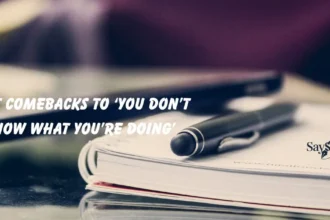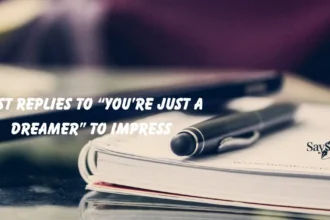Effective communication thrives on engagement, and asking for feedback in different ways can make your conversations more dynamic. If you find yourself soliciting feedback or requesting opinions using the same phrase repeatedly, it may start to feel monotonous.
By diversifying language, you can keep your interactions fresh and encourage thoughtful responses. A simple change in wording can go a long way in making interactions dynamic and inviting, ensuring your audience feels valued. When you’re gathering insights from colleagues, customers, or friends, finding new ways to express yourself helps in communicating effectively and keeping discussions engaging.
In this article, we’ll explore creative alternatives to Let me know what you think to help you improve your communication and make a lasting impression!
The Power of Asking for Feedback
Asking for feedback is a fundamental aspect of effective communication. Whether in a professional setting, casual conversation, or online interactions, soliciting feedback plays a pivotal role in personal growth, improvement, and fostering meaningful connections.
It not only helps in refining ideas or actions but also encourages collaboration and opens the door to diverse perspectives.
Requesting opinions allows you to gain insights that you might not have considered, enabling you to make more informed decisions. But simply asking for feedback isn’t enough; the way you ask can significantly impact the quality of responses you receive.
Diversifying language and switching up your approach can help in keeping conversations fresh and make your interactions more engaging and welcoming.
When you create an environment that encourages thoughtful responses, you build trust and openness, ultimately leading to more productive discussions. By making interactions dynamic and inviting, you pave the way for more meaningful and constructive feedback, allowing you to continuously improve and evolve.
In a world where effective communication is key, asking for feedback is one of the most powerful tools to enhance your personal and professional relationships.
1. I’d love to hear your thoughts on this!
Story:
Imagine you’ve just finished a presentation for a new project at work. You want to get feedback from your colleagues, Jane and Mike, to gauge their reactions and improve your approach moving forward.
When to Use:
This phrase is great when you’re seeking genuine feedback in an enthusiastic yet respectful manner. It works well when you’re excited to hear others’ opinions and want to make them feel comfortable sharing their thoughts.
When Not to Use:
Avoid using this phrase in situations where you need quick or specific feedback. It may come across as too informal or unnecessary when you need to gather precise input or are dealing with a time-sensitive matter.
Example:
You: I’d love to hear your thoughts on this presentation, Jane. Do you think I covered all the important points?
Jane: I think you did a great job, but maybe you could slow down a bit during the summary.
How to Respond 🗣️:
You can thank Jane for her input and ask for further clarification.
You: Thanks for the feedback, Jane! I’ll work on pacing myself better in future presentations.
2. What’s your take on this?
Story:
You’ve just drafted a marketing campaign idea and want to hear what your colleague, Sarah, thinks about it before presenting it to your boss.
When to Use:
This phrase is ideal when you’re asking for a more general, open-ended opinion. It invites people to share their thoughts freely and is perfect for collaborative environments.
When Not to Use:
It’s not the best choice when you need feedback on specific details or when you want someone to focus on particular areas, such as the accuracy of facts or the design layout.
Example:
You: What’s your take on this marketing campaign, Sarah?
Sarah: I think it’s a great concept, but I feel the color scheme could be more vibrant.
How to Respond 🗣️:
You could agree and ask for suggestions.
You: Thanks for your feedback, Sarah! Do you have any ideas for a better color scheme?
3. Could you share your opinion on this?
Story:
After completing a draft for a new product design, you turn to your team member, Tom, and ask for his opinion on the final version.
When to Use:
Use this when you want to sound professional and polite. It’s useful when you want to gather thoughtful and considered feedback from others.
When Not to Use:
Avoid using this if you want quick, casual feedback or if the situation requires a more laid-back tone.
Example:
You: Could you share your opinion on this product design, Tom?
Tom: I like the design, but I think we should make the buttons a bit more prominent.
How to Respond 🗣️:
You could acknowledge the suggestion and ask for more details.
You: Thanks for your thoughts, Tom! Could you clarify which part of the design you think needs the button change?
4. How do you feel about this?
Story:
You’ve just written a blog post about a new product feature and want to know how your editor, Linda, feels about the tone and style.
When to Use:
This phrase works well when you want to understand the emotional or personal reaction someone might have to your work. It’s ideal when discussing creative projects.
When Not to Use:
It’s not suitable for situations where you need objective or specific feedback on technical aspects or details.
Example:
You: How do you feel about this blog post, Linda?
Linda: I think the tone is spot on, but maybe we could make the introduction more engaging.
How to Respond 🗣️:
You can express appreciation and seek more specific advice.
You: I appreciate that, Linda! Any ideas on how to make the introduction more engaging?
5. What do you think about this approach?
Story:
After brainstorming strategies for the upcoming project, you turn to your coworker, James, for his thoughts on your chosen direction.
When to Use:
This phrase is perfect for soliciting feedback on a particular plan, idea, or strategy, especially when you want a more focused opinion.
When Not to Use:
It may not be suitable when you’re looking for overall impressions or casual feedback, as it directs the conversation toward a specific aspect.
Example:
You: What do you think about this approach for the project, James?
James: I think it’s a solid plan, but we might need a backup strategy in case of any roadblocks.
How to Respond 🗣️:
You can accept the feedback and engage in a deeper conversation.
You: Great point, James! I’ll make sure to add a backup plan in case things don’t go as expected.
6. I’d appreciate your feedback on this.
Story:
You’re about to launch a new software feature and want the team’s input on its functionality and usability before going public. You ask your colleague, Emma, for her feedback.
When to Use:
This phrase is a polite and formal way to request input. It’s appropriate when you’re seeking constructive criticism or need feedback before moving forward with a project.
When Not to Use:
Avoid this when you need casual feedback or when the situation doesn’t call for a formal request.
Example:
You: I’d appreciate your feedback on this new feature, Emma. Does it meet the user’s needs?
Emma: I think the feature is great, but the interface could be more intuitive.
How to Respond 🗣️:
You can thank Emma and express willingness to make improvements.
You: Thanks for the feedback, Emma! I’ll work on simplifying the interface.
7. How does this look to you?
Story:
You’ve finished designing a new layout for a website and want to get your designer, Alex’s, opinion on the visual appeal and functionality.
When to Use:
This phrase is casual and effective for seeking immediate feedback on design or visuals. It works well in informal settings or when you’re close to your team members.
When Not to Use:
Avoid using this when you’re asking for detailed, in-depth feedback on more technical or complex aspects of your work.
Example:
You: How does this layout look to you, Alex?
Alex: The design is good, but I think the text could be easier to read with a different font.
How to Respond 🗣️:
You can agree and ask for suggestions on improvements.
You: Thanks for the tip, Alex! Do you have any font suggestions in mind?
8. What’s your opinion on this idea?
Story:
You’ve come up with a new business concept and want to hear what your business partner, Olivia, thinks about its potential.
When to Use:
Use this phrase when you want a straightforward opinion on a specific idea. It’s perfect for seeking honest feedback in a professional or business context.
When Not to Use:
It’s not the best choice for gathering feedback on broad topics or when you’re looking for a deeper discussion.
Example:
You: What’s your opinion on this business idea, Olivia?
Olivia: I think it has potential, but we may need to tweak the pricing strategy.
How to Respond 🗣️:
You can accept the input and discuss potential changes.
You: Thanks for the insight, Olivia! I’ll revisit the pricing strategy and make adjustments.
9. Let me know your thoughts when you get a chance.
Story:
After sending an email with your latest project update, you want to give your colleague, Carlos, time to review it and share his thoughts whenever he’s free.
When to Use:
This phrase is ideal when you don’t need immediate feedback but want to let the person know you’re open to hearing their opinion when they’re ready.
When Not to Use:
Avoid using it if the feedback is time-sensitive or if you’re expecting a quick response.
Example:
You: Let me know your thoughts when you get a chance, Carlos. I’d appreciate any feedback.
Carlos: I’ll review it by tomorrow and send you my thoughts.
How to Respond 🗣️:
You can acknowledge their timing and thank them for their upcoming input.
You: Thanks, Carlos! I look forward to your feedback tomorrow.
10. What’s your feedback on this?
Story:
You’ve just wrapped up a marketing report and want to get feedback from your supervisor, Mark, on the overall content and structure.
When to Use:
This phrase is clear and direct, making it ideal for requesting detailed feedback on the work itself, whether it’s content, structure, or presentation.
When Not to Use:
Avoid using this if you want a broader opinion or if you’re looking for a more informal, open-ended conversation.
Example:
You: What’s your feedback on this marketing report, Mark?
Mark: The report looks good, but I’d suggest adding a section on customer insights for more depth.
How to Respond 🗣️:
You can thank Mark for the advice and take action accordingly.
You: Thanks for the feedback, Mark! I’ll add the customer insights section right away.
11. How would you handle this?
Story:
You’re facing a challenge at work and want to get your manager, Laura’s, perspective on how she would approach the situation.
When to Use:
This phrase is ideal when seeking advice or guidance on a problem or decision-making process. It’s great for brainstorming solutions with experienced colleagues.
When Not to Use:
Avoid using it if you’re looking for direct approval or if you’ve already decided on an approach and just want confirmation.
Example:
You: How would you handle this client complaint, Laura?
Laura: I’d start by acknowledging their concerns and offering a personalized solution.
How to Respond 🗣️:
You can express appreciation and discuss implementing the advice.
You: That’s a great approach, Laura. I’ll reach out to the client and ensure they feel heard.
12. What are your thoughts on this?
Story:
You’ve prepared a proposal for a new project and want feedback from your colleague, Brian.
When to Use:
This is a versatile phrase that works well in both casual and formal settings when seeking general opinions.
When Not to Use:
It may not be the best choice when you need highly specific or technical feedback.
Example:
You: What are your thoughts on this new proposal, Brian?
Brian: It looks solid, but I think we should add a cost analysis.
How to Respond 🗣️:
You can acknowledge the suggestion and refine your work.
You: Great point, Brian! I’ll include a cost analysis before submitting it.
13. I’m interested in hearing your views on this.
Story:
During a team meeting, you present a new workflow idea and want to hear what your team member, Susan, thinks.
When to Use:
Use this when you want to encourage open discussion and make the other person feel valued.
When Not to Use:
Avoid it in time-sensitive situations where you need quick, actionable feedback.
Example:
You: I’m interested in hearing your views on this new workflow, Susan.
Susan: I like the efficiency, but we may need additional training for the team.
How to Respond 🗣️:
You can acknowledge her point and discuss next steps.
You: Good insight, Susan! I’ll arrange a training session to ensure a smooth transition.
14. Do you have any feedback on this?
Story:
You’ve drafted a press release and want input from your editor, Paul.
When to Use:
This phrase is direct and useful when requesting specific feedback in a professional setting.
When Not to Use:
It may not be ideal if you’re looking for general opinions rather than constructive criticism.
Example:
You: Do you have any feedback on this press release, Paul?
Paul: Yes, the content is strong, but we need to refine the headline.
How to Respond 🗣️:
You can thank Paul and ask for further clarification.
You: Thanks, Paul! Any suggestions on how to make the headline more compelling?
15. What’s your reaction to this?
Story:
You show your friend a new product concept and want to gauge their immediate response.
When to Use:
Use this when you’re looking for a quick and natural first impression.
When Not to Use:
Avoid using it when seeking in-depth feedback on technical details.
Example:
You: What’s your reaction to this product idea?
Friend: It’s interesting! I love the design, but I’m not sure about the color.
How to Respond 🗣️:
You can dive deeper into their response.
You: Good to know! What colors do you think would work better?
16. How does this sit with you?
Story:
After proposing a new policy to your team, you want to check their comfort level with the change.
When to Use:
This phrase is great for assessing emotional reactions and gauging acceptance.
When Not to Use:
It’s not suitable for highly technical or data-driven discussions.
Example:
You: How does this new policy sit with you?
Team Member: It makes sense, but I think we need more time to adjust.
How to Respond 🗣️:
You can acknowledge their concern and offer a solution.
You: That’s fair. We can introduce it gradually to ease the transition.
17. I’d like to know your opinion on this matter.
Story:
During a department meeting, you ask your supervisor, Rachel, for her thoughts on a strategic decision.
When to Use:
This phrase is formal and appropriate in professional or serious discussions.
When Not to Use:
It may sound too formal in casual conversations.
Example:
You: I’d like to know your opinion on this strategy, Rachel.
Rachel: It’s a good plan, but we should consider potential risks.
How to Respond 🗣️:
You can ask for clarification.
You: That’s a great point! What risks should we prioritize?
18. Could you provide your input on this?
Story:
You’re finalizing a marketing campaign and need your manager’s input before launching.
When to Use:
Use this when requesting valuable insights from someone with expertise.
When Not to Use:
Avoid it if you’re just looking for casual opinions rather than actionable feedback.
Example:
You: Could you provide your input on this campaign, Sarah?
Sarah: Sure! I think we should tweak the messaging to align with our brand tone.
How to Respond 🗣️:
You can acknowledge and refine your work.
You: Thanks, Sarah! I’ll adjust the messaging to better match our brand.
19. What are your impressions of this?
Story:
You’ve completed a website redesign and want to hear your client’s first impressions.
When to Use:
This phrase is useful when asking for an overall perspective rather than detailed feedback.
When Not to Use:
It may not be the best choice if you need structured feedback on specific aspects.
Example:
You: What are your impressions of this new website design?
Client: It looks fresh and modern, but the navigation feels a bit cluttered.
How to Respond 🗣️:
You can ask for clarification and suggest improvements.
You: Got it! I’ll simplify the navigation to improve the user experience.
20. How do you see this?
Story:
You’re brainstorming a company rebranding and want to know how your creative director, Emma, perceives the new vision.
When to Use:
This phrase is useful when seeking a subjective or conceptual perspective.
When Not to Use:
It’s not the best choice when you need factual or data-based feedback.
Example:
You: How do you see this new branding concept, Emma?
Emma: I see it as a bold step forward, but we might need to refine the logo for better clarity.
How to Respond 🗣️:
You can build on their insights.
You: Great perspective, Emma! Let’s refine the logo while keeping the bold essence.
21. What do you make of this?
Story:
You’re showing a draft of a business presentation to your mentor, Steve, and want his initial reaction.
When to Use:
This phrase is great for informal feedback and encourages an open-ended response.
When Not to Use:
Avoid it if you need highly structured feedback with specific details.
Example:
You: What do you make of this presentation, Steve?
Steve: It’s strong overall, but the introduction could be more engaging.
How to Respond 🗣️:
You can acknowledge and refine your work.
You: Good point, Steve! I’ll work on making the intro more captivating.
22. I’m keen to hear your feedback on this.
Story:
You’ve created a new training manual and want to gather thoughts from your team leader, Jessica.
When to Use:
Use this when you genuinely value and anticipate feedback from the other person.
When Not to Use:
It may sound overly eager if you’re just looking for minor tweaks rather than substantial feedback.
Example:
You: Jessica, I’m keen to hear your feedback on this training manual.
Jessica: It’s well-structured, but we could simplify the language for better clarity.
How to Respond 🗣️:
You can acknowledge and adjust.
You: Thanks, Jessica! I’ll simplify some sections for easier understanding.
23. What’s your assessment of this?
Story:
Your team has completed a customer service initiative, and you ask your manager, Mark, for his evaluation.
When to Use:
This phrase is ideal for formal or professional evaluations of work, projects, or performances.
When Not to Use:
It might sound too formal for casual feedback situations.
Example:
You: What’s your assessment of our customer service initiative, Mark?
Mark: We improved response time, but customer satisfaction ratings stayed the same.
How to Respond 🗣️:
You can dig deeper into the details.
You: Thanks, Mark! Do you think additional training could help boost satisfaction?
24. Can you provide your thoughts on this?
Story:
You’re submitting a report for review and ask your colleague, Sarah, for her input.
When to Use:
This phrase is direct and polite, making it suitable for both casual and professional settings.
When Not to Use:
Avoid using it when you need a quick yes/no answer rather than detailed feedback.
Example:
You: Can you provide your thoughts on this report, Sarah?
Sarah: It’s thorough, but I think a summary section at the end would help.
How to Respond 🗣️:
You can acknowledge and refine your work.
You: Great suggestion! I’ll add a summary before finalizing it.
25. What do you think of this idea?
Story:
You’ve brainstormed a new marketing campaign and want your teammate, Alex, to weigh in.
When to Use:
This is perfect for casual brainstorming sessions when you need creative input.
When Not to Use:
It may not be ideal if you require analytical or data-driven feedback.
Example:
You: What do you think of this idea for our campaign, Alex?
Alex: It’s unique! We just need to ensure it aligns with our brand voice.
How to Respond 🗣️:
You can discuss how to refine the concept.
You: Good point, Alex! Let’s tweak it to maintain consistency.
26. How do you view this?
Story:
You present a project update to your client, Julia, and want to know her perspective.
When to Use:
This phrase is useful when seeking a personal interpretation or viewpoint.
When Not to Use:
Avoid using it if you need precise, factual feedback rather than subjective input.
Example:
You: How do you view this latest update, Julia?
Julia: It’s progressing well, but I’d like to see a timeline for the next steps.
How to Respond 🗣️:
You can address her concern and offer a solution.
You: I’ll prepare a detailed timeline and send it over.
27. What’s your take on this matter?
Story:
During a strategy meeting, you ask your colleague, Daniel, for his thoughts on a business challenge.
When to Use:
Use this when discussing broad or complex topics that require thoughtful input.
When Not to Use:
It might be too formal for quick, simple questions.
Example:
You: What’s your take on this market shift, Daniel?
Daniel: It’s a challenge, but we can adapt by focusing on digital expansion.
How to Respond 🗣️:
You can build on his ideas.
You: That’s a solid approach! Let’s explore digital expansion strategies.
28. I’m interested in your thoughts on this topic.
Story:
You’re discussing a trending industry topic with your colleague, Megan, and want to know her opinion.
When to Use:
This phrase is great for inviting meaningful discussions, especially in professional settings.
When Not to Use:
It may not be suitable if you’re looking for quick, surface-level feedback.
Example:
You: I’m interested in your thoughts on this new industry regulation, Megan.
Megan: It could create challenges, but also opportunities for innovation.
How to Respond 🗣️:
You can encourage further discussion.
You: Interesting! What kind of innovations do you foresee?
29. Can you give me your feedback on this?
Story:
You’ve drafted a project proposal and want your boss, Tom, to review it.
When to Use:
This phrase is polite and effective when requesting direct and constructive feedback.
When Not to Use:
Avoid using it if you’re not ready to make changes based on the feedback.
Example:
You: Can you give me your feedback on this proposal, Tom?
Tom: It’s well-structured, but the budget section needs more details.
How to Respond 🗣️:
You can acknowledge and refine the section.
You: Thanks, Tom! I’ll add more details to clarify the budget.
30. What’s your opinion on how this turned out?
Story:
After launching a new company website, you ask your colleague, Rachel, for her feedback.
When to Use:
This phrase is great for evaluating completed projects or events.
When Not to Use:
It may not be ideal for ongoing projects where feedback is still shaping the outcome.
Example:
You: What’s your opinion on how the website redesign turned out, Rachel?
Rachel: It’s visually appealing, but we might need to improve loading speed.
How to Respond 🗣️:
You can discuss possible improvements.
You: Good point! I’ll check with the developers to optimize the speed.
31. How well do you think this meets expectations?
Story:
You’ve just finished drafting a client proposal and want to know if it aligns with the client’s requirements.
When to Use:
Use this when checking if something meets a specific standard or expectation.
When Not to Use:
It may not be suitable if the expectations haven’t been clearly defined beforehand.
Example:
You: How well do you think this proposal meets the client’s expectations, Mark?
Mark: It covers most of the key points, but we should expand on pricing details.
How to Respond 🗣️:
You can acknowledge and refine.
You: Good catch, Mark! I’ll add more clarity to the pricing section.
32. Is there anything you would change about this?
Story:
You’ve designed a new company logo and ask your colleague, Sarah, for suggestions.
When to Use:
This phrase is great for inviting constructive criticism and improvements.
When Not to Use:
Avoid it if you’re not open to making changes.
Example:
You: Is there anything you would change about this logo, Sarah?
Sarah: The color scheme is nice, but maybe a bolder font would stand out more.
How to Respond 🗣️:
You can consider the suggestion.
You: Great idea! I’ll try out some bold font options.
33. How do you think this could be improved?
Story:
You’ve prepared a new employee training guide and want insights from HR.
When to Use:
This phrase is ideal when actively looking for ways to enhance something.
When Not to Use:
Avoid it if you’re looking for general feedback rather than specific improvements.
Example:
You: How do you think this training guide could be improved, Emma?
Emma: It’s informative, but adding real-world case studies would make it more engaging.
How to Respond 🗣️:
You can show appreciation and implement changes.
You: Great point, Emma! I’ll add some case studies to make it more relatable.
See also: “Powerful Replies to Say When You Hear Hallelujah”
34. Do you think this accomplishes its goal?
Story:
You’ve created an ad campaign and want to check if it effectively conveys the message.
When to Use:
This phrase helps evaluate whether something achieves its intended purpose.
When Not to Use:
It may not be helpful for highly subjective feedback.
Example:
You: Do you think this campaign accomplishes its goal, Alex?
Alex: It’s eye-catching, but we should clarify the call to action.
How to Respond 🗣️:
You can fine-tune the campaign.
You: Good insight! I’ll revise the CTA to make it clearer.
35. Would you recommend any adjustments?
Story:
You’ve drafted a newsletter and want your marketing manager’s input.
When to Use:
Use this phrase when looking for small tweaks rather than major overhauls.
When Not to Use:
It may not be the best choice if you need deep, analytical feedback.
Example:
You: Would you recommend any adjustments to this newsletter, Lisa?
Lisa: It’s well-written, but a stronger headline would attract more readers.
How to Respond 🗣️:
You can refine based on the suggestion.
You: I see what you mean! I’ll brainstorm some more impactful headlines.
Top Editor Choice Responses
- That’s a great point! I’ll work on refining that.
- I see what you mean. Let me tweak that section.
- Thanks for your insight! I’ll incorporate that change.
- That’s an interesting perspective. Can you elaborate?
- I appreciate your feedback! I’ll explore ways to improve this.
- I hadn’t considered that—thanks for pointing it out!
- Good catch! I’ll make sure to adjust that.
- That’s helpful! I’ll look into making that clearer.
- I understand your concern. Let me see how I can address it.
- I see where you’re coming from. I’ll work on a solution.
- That’s a valid point. I’ll take another look at it.
- I appreciate your honesty! I’ll make the necessary revisions.
- That’s an interesting take. I’ll consider that for improvement.
- I can see how that could be clearer. I’ll work on it.
- Thanks for catching that! I’ll make sure to correct it.
- I’ll take your feedback into account and adjust accordingly.
- That’s a valuable suggestion! I’ll see how I can apply it.
- I appreciate your perspective! I’ll refine this further.
- That’s a good idea! I’ll work on making that change.
- Thanks for the feedback! I’ll make sure to enhance this.
Conclusion
In conclusion, asking for feedback and responding to it effectively are crucial elements of growth, improvement, and collaboration. By diversifying the way we request feedback, we can keep conversations fresh, encourage more thoughtful responses, and make interactions more engaging.
When you’re asking for opinions, input, or suggestions, using varied and creative phrases can help communicate your openness and foster better dialogue.
Moreover, having a solid collection of responses ready when receiving feedback ensures you can handle the conversation with clarity, professionalism, and a willingness to improve.
Remember, feedback is not only about receiving insights, it’s about using those insights to continuously evolve and refine your work, your ideas, and your relationships.

I’m Lily Hart, the Admin behind the engaging responses at SayStyles.com! With a knack for blending wit and warmth, I turn every piece of writing into something memorable. From clever advice to fun comebacks, I’m here to make sure every response leaves you smiling and thinking.






